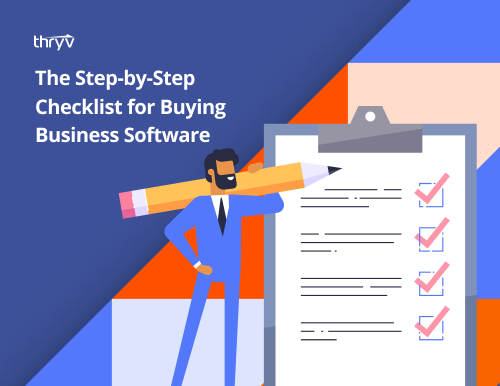You need help. You know you need help. nd you know there’s specialized small business software out there that can help you.
Problem is, you don’t control the purse strings.
So how do you get the funds for technology that would help not only you, but improve how work gets done in your organization? Improvements that can result in greater efficiencies, and — most importantly — money not only saved but earned?
To successfully convince your boss to buy technology or business management software, make sure you’ve checked off the following.

Free: Buying Software Checklist
DownloadKnow Your Audience
Unless you’re a lone wolf, usually there is more than one person who has to sign off on a tech purchase. In fact, according to research and consulting firm Gartner, there are anywhere from six to 10 people involved in complex business-to-business buying decisions.
The only thing that drives purchase is quality information presented in an accessible way.
—Forbes
The technology you want to buy may not be complex, and your organization may not be as big as the ones involved in the Gartner research. Still, unless you own the business, you likely have to satisfy questions coming from at least these roles, if not more:
- IT
- Finance
- Legal and/or Compliance
- Operations
The same person may be wearing several (or all) of those hats, but each role has a particular point of view and criteria you need to satisfy.
Before you identify a solution, you’ll want to understand what each of those roles has to consider before approving a purchase. You don’t want to fall in love with a technology tool only to find out it has a non-negotiable flaw.
Which Problems Are You Fixing?
Of course, what you also need to address is the problem you’re solving. Are you sure your boss sees the problem the same way you do?
Sure, some processes may be manual. But be prepared to answer why that’s a bad thing. Do manual processes lead to more errors? Then that’s the issue you want to solve. List the errors that could be avoided with the new tool.
Then, show your “buying committee” what will improve. If you successfully convince your boss to buy this technology, whose time will this free up? What will they be able to use that time for?
Ideally, you’re automating repetitive, nonstrategic tasks and freeing up staff time to focus on more strategic initiatives (read: bringing in more money).
If you’ve done your work understanding the concerns of the different roles in your organization, then include that information to show how various teams support the new tool.
And above all, take care not to belittle or turn up your nose at the choices or efforts of those who came before you.
24% of small business owners spend five to 10 hours each week on administrative tasks alone.
—Zapier
Quantify Money and Time
If you know how much money you’ll save (or costs you’ll avoid) by taking on a new tool, you can lead your argument with that. Bonus points if you can illustrate how much more you’ll earn. Those are clear winners.
But time savings is squishier. Before you ask your “committee” to simply trust you on how much time will be saved, do some legwork first.
What are the negatives of your current processes? List the specifics on exactly what buying this technology will improve and by how much.
- How many hours a day/month/year will you get back by using this tool? Translate that into dollars for added effectiveness.
- Have you implemented other ways to save time and money before arriving at this solution? Why wasn’t that enough?
- What other tools have you looked into, and how much do they cost? Why is this solution the most cost-effective of all the choices? (Most cost-effective doesn’t have to mean cheapest.)
94% of small business employees say they perform repetitive, time-consuming tasks.
—Small Business Trends
Host a Tech Bake-Off
Say you’ve done all the above homework. You’ve arrived at two equally viable solutions. How do you choose?
It’s test-drive time.
Depending on the situation, you may be able to test each tool in a live setting. Some technologies offer free trials, others have an entry-level product at a low price point.
Unless it’s prohibitively complicated (or restricted by regulation) to take a tool on a test run, give yourself a few weeks to work with it. Try it using your real-life situations. Kick the tires.
Get a sense of how it will — or won’t — help you. Then take your findings back to your buying committee.
The most realistic bake-offs result in the most successful implementations.
—The Real Story Group
Which Pain Do You Choose?
To many people, change=pain. And if current processes are just fine in your boss’s eyes, you have an uphill battle trying to prove change is a good idea. Particularly if that boss used to do what you do now.
Change can bring pain, that’s true. But if you can, point out how the status quo is more painful. You need to show that the pain of staying the same is greater than the pain of change.
If you want to successfully convince your boss to buy technology, show how it will improve the organization’s chances of achieving its goals. And how they won’t be achieved without it.
Yes, new tech tools are great. And across the board, technology has brought many improvements. But that isn’t an argument. Your buying committee won’t buy into tech for tech’s sake.



